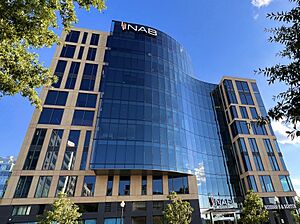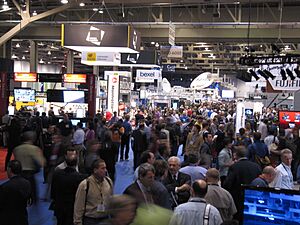National Association of Broadcasters facts for kids
 |
|
| Legal status | 501(c)(6) |
|---|---|
| Location | |
|
President
|
Curtis LeGeyt |
|
Revenue
|
|
The National Association of Broadcasters (NAB) is a group that represents the radio and television stations you can watch and listen to for free in the United States. It acts as a voice for both commercial stations (that play ads) and non-commercial stations.
The NAB speaks for over 8,300 local radio and TV stations, as well as the big broadcast networks. Think of it as a team that helps all these stations work together and talks to the government about rules for broadcasting. The current president and CEO of the NAB is Curtis LeGeyt.
Contents
History of the NAB

The NAB was started in April 1923 in Chicago. At first, it was called the National Association of Radio Broadcasters (NARB) because television wasn't common yet. Its founder was Eugene F. McDonald Jr., who also started the company Zenith Electronics.
As television became popular, the group changed its name in 1951 to include TV stations. In 1958, it became the National Association of Broadcasters, the name it still uses today.
The Start of Commercial Radio
In the early days of radio, there was a big debate. Should radio be commercial, with companies paying for ads, or should it be non-profit and funded by the public, like the BBC in the United Kingdom?
The NAB supported the idea of commercial radio. In 1928, the government created new rules that gave the best radio channels and broadcast times to commercial stations. Groups of educators and non-profits argued against this. They worried that commercial radio would only care about making money, not about making high-quality shows.
In the end, the commercial radio supporters won, and the Communications Act of 1934 helped create the system of ad-supported radio we have in the U.S. today.
The NAB and New Technology
Satellite Radio
When satellite radio services like XM and Sirius first appeared, the NAB was concerned. The organization argued against the government's approval of these new services.
Later, when XM and Sirius decided to merge into one company, the NAB protested again. It worried that a single, large satellite radio company could become a "monopoly" (a company with too much control over an industry).
The Switch to Digital TV
In the 2000s, television stations in the U.S. switched from broadcasting an analog signal to a digital one. This meant many older TVs wouldn't be able to get the new signal.
To help people, the NAB worked on a project to create a small, low-cost box that could convert the new digital signal back to analog. This allowed people to keep using their old TVs after the switch. The U.S. government even used the NAB's design for its coupon program to help people buy these converter boxes.
Debate Over "White Spaces"
"White spaces" are unused radio frequencies that sit between TV channels. Some companies wanted to use these empty channels to provide wireless internet service.
The NAB was against this idea. It claimed that using the white spaces for internet could interfere with TV signals and make them fuzzy. However, the Federal Communications Commission (FCC), the government agency in charge of broadcasting, ran tests. The tests showed that using the white spaces was safe and would not cause problems for TV viewers.
Big Events and Meetings
Every spring, the NAB holds a huge convention in Las Vegas called the NAB Show. It's one of the biggest gatherings for the media and entertainment industry in the world. Over 50,000 professionals from about 155 countries attend to see the latest technology for making movies, TV shows, and radio programs.
In the past, popular technologies at the show have included 3D video (inspired by the movie Avatar), small point-of-view cameras, and special digital cameras that create cool visual effects.
Rules for Broadcasting
In 1952, the NAB created a set of rules called the Code of Practices for Television Broadcasters. This code set standards for what could be shown on TV. It limited things like showing crime in detail and other content that was considered inappropriate for families at the time.
A court decision in 1983 ended the official Code. Today, the NAB encourages stations to use "responsible and careful judgment" when choosing what to air.
In March 2022, after the Russian invasion of Ukraine, the NAB asked U.S. broadcasters to stop showing any programs that were sponsored by the Russian government.
NAB Hall of Fame
The NAB honors famous people and classic shows by adding them to its Broadcasting Hall of Fame.
| Year | Television | Radio |
|---|---|---|
| 2000 | Saturday Night Live | Tom Joyner |
| 2001 | Ted Koppel | "Cousin Brucie" Bruce Morrow |
| 2002 | Rowan and Martin's Laugh-In | Dick Orkin |
| 2003 | Walt Disney anthology television series | Scott Shannon |
| 2004 | Roger King | Mormon Tabernacle Choir "Music and the Spoken Word" |
| 2005 | The Tonight Show | Jack Buck |
| 2006 | Regis Philbin | Dick Purtan |
| 2007 | Meet the Press | Rick Dees |
| 2008 | Bob Barker | Larry Lujack |
NAB Awards
Each year, the NAB gives out special awards to honor excellence in broadcasting.
- NAB Marconi Radio Awards: Given to the best radio stations and on-air personalities.
- NAB National Radio Award: Honors an important leader in the radio industry.
- NAB Crystal Radio Awards: For radio stations that do outstanding work to serve their local communities.
- NAB Engineering Achievement Awards: Recognizes individuals who have made great technical achievements in broadcasting.
- NAB Distinguished Service Award: A special honor for people who have made a lasting, positive impact on American broadcasting.
See also
 In Spanish: National Association of Broadcasters para niños
In Spanish: National Association of Broadcasters para niños
- Code of Practices for Television Broadcasters—The set of rules for TV content used from 1952 to 1983.


